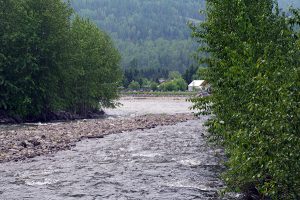Home »

Knowing where the Elk River may go
By Lee-Anne Walker
Elk River Current Article #4
To better understand flooding in the Elk Valley, the Elk River Alliance (ERA) joined forces with University of Lethbridge scientists and professional engineers to model historic and projected flood events. We are now better able see where floods have and will go in the future models and how deep the water might be.
Hydrological models were also created for the Elk River Flood Strategy to investigate the impact of land use and climate change over time in the Elk River Watershed. These models took into account data collected on meteorological inputs, such as air temperature and precipitation, and watershed features such as vegetation and soil, and how much water is conveyed to the stream. Soil types, surficial geology, topography, land use, and other supporting datasets characterize the watershed and affect runoff differently.
Land use change was simulated as a 3,100 hectare (ha) forest harvest scenario, representing approximately five years of timber harvest at the current annual allowable cut in the Elk Valley. Climate change was projected in two models of varying severity. In general air temperatures and winter precipitation were projected to increase under these scenarios. Summer precipitation was projected to decrease. Warmer and wetter winters and dryer summers are in our future.
Projected streamflow simulations suggest that climate change has a greater affect on runoff than land use does alone. The simulations show that runoff is expected to be earlier in the spring period, and higher snowpack in the winter may result in higher spring streamflows. The climate change simulations resulted in increases in daily peak streamflows between 6.3% and 6.5%. Land use change scenarios suggest the removal of forest cover at lower elevations would increase runoff in the early spring and slightly decrease it during June.
Currently, there is limited historical evidence to suggest that flooding in the Elk Valley has changed at this point in time. However, given hydrologic modelling data, it appears that climate change may affect the streamflow to a significant degree. Ensuring the Elk maintains resiliency to future change, allowing the river to behave in a natural manner, is critically important. It is important that we try to understand the Elk River’s movements within the floodplain, although many community members do not know where the floodplain is located.

In order to bridge the gap in community understanding, a hydraulic model was developed for the Elk River up stream of Hosmer to Coal Creek mouth in Fernie. Modelling was limited to this area due to funding constraints and availability of quality GIS data for this reach.
This model was based on high-resolution digital elevation data and field surveys, and provides a means of evaluating flood events. In addition to this model, a web-based visualization tool was developed to deliver this information to the public. This tool is available to the public at elkriveralliance.watersimulation.ca and allows access to hydraulic model information that was not previously available.
This online visualization tool can help members of the community see the breadth and depth of flooding in the Elk Valley, as the model is two dimensional and shows the topography of the landscape. This tool has many practical applications, and allows members of the Elk Valley to make informed decisions based on the available flood information. It helps illustrate why municipal zoning restricts permanent residents in places like Maiden Lake and north toward the Elk River. People can also see if the home they are interested in buying or building is likely to flood, and rationale for flood proofing their homes.
To learn more about flood inundation and reducing flood damages, check out the Elk River Flood Strategy at www.elkriveralliance.ca.
Learn more about the community-based water monitoring.
– Lee-Anne Walker, MA Environment and Management is Community Water Champion and Executive Director of Elk River Watershed Alliance (ERA)







